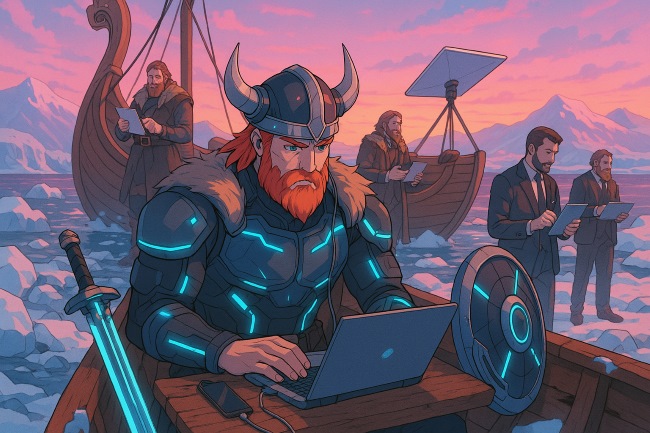The Norse settlement of Iceland offers timeless lessons for those pondering the intricacies of prosperity across the ages, as echoed in modern economic reflections like those from the World Economic Forum. The tale begins with a storm around 860 AD: Naddoðr, a Norse mariner, is blown off course and glimpses a vast, unclaimed island he dubs Snæland (Snowland). This moment, later chronicled in the Landnámabók (Book of Settlements), ignites a wave of deliberate migration to Iceland. Yet, to dismiss this as a mere historical curiosity is to overlook its potency as a gritty case study in wealth creation—one laced with ambition, resource exploitation, societal innovation, and stark consequences. These aren’t blueprints for today but echoes from the past, offering a lens on how wealth once took shape.
Lesson 1: Opportunity is Recognized, Not Just Encountered
Naddoðr’s discovery was a fluke, but what followed was anything but random. Word of an uninhabited land, far from the tightening grip of Norway’s Harald Fairhair, stirred calculated ambition. Ingólfr Arnarson and other pioneers didn’t drift aimlessly westward; they launched expeditions informed by reconnaissance, balancing the perils of uncharted seas against the promise of untapped territory, as detailed in JSTOR’s analysis of Norse migration motives. Opportunity, then as now, isn’t about luck—it’s about the acuity to spot potential and the resolve to muster resources (ships, crew, capital) to seize it amid uncertainty. This strategic foresight mirrors how elite families historically turned crises into opportunities, a theme explored in After the Storm: How Wealthy Families Turned Crises into Opportunities for Preservation.
The political upheaval in Norway fueled this exodus, a dynamic some see reflected in today’s entrepreneurial landscape. Modern parallels emerge in how technology reshapes opportunity recognition, as discussed in From the Wheel to AI: How Technology Reshapes Humanity, where strategic adaptation remains key to thriving amid change.
Lesson 2: Wealth is Built on a Defensible Economic Base
For the settlers, land was the bedrock of wealth—landnám (“land-take”) wasn’t just a term but a mission, as outlined in Oxford Academic’s study of early Icelandic resources. Yet, it wasn’t mere possession that mattered; it was productive land for grazing livestock, access to timber (soon exhausted), and the capacity to secure labor and allegiance. This wasn’t random accumulation—it was the creation of a defensible economic foundation. Today, this principle resonates in building resilient systems, whether through diversified assets or networks, a concept unpacked in From Resilience to Riches: How Diversification and Networks Saved Fortunes.
The settlers’ intuitive grasp of resource allocation aligns with modern competitive strategies, as noted in HBR’s resource-based view. A contemporary twist lies in AI’s role in fortifying economic bases, as explored in How AI Can Help You Build and Preserve Wealth: A Strategic Guide for High-Net-Worth Individuals, where technology becomes the new timber for enduring prosperity.
Lesson 3: The Economics of Autonomy
Fleeing Norway’s rulers wasn’t just about dodging taxes—it was a quest for autonomy. The settlers forged a society with the Icelandic Commonwealth’s Althing, one of the world’s earliest parliaments, as detailed in Cambridge’s socio-political analysis. This wasn’t merely about retaining profits; it was about securing the freedom to innovate and govern locally. Today’s entrepreneurs echo this spirit, seeking independence from rigid structures, a pursuit mirrored in The Future of Wealth Management in Dubai: AI, Blockchain, and a Digital Economy, where decentralized tools empower new economic models.
Autonomy’s edge lies in agility, much like the settlers’ swift adaptations. This agility is a thread through history, from medieval city-states to modern innovators, and finds a cutting-edge expression in The Three Waves of AI Wealth Creation: From Efficiency to Transformation, highlighting how autonomy fuels innovation in an AI-driven age.
Lesson 4: The Unseen Liabilities of Resource Windfalls
Iceland’s allure lay in its “free” bounty—forests, grazing lands, a blank slate. But this windfall hid a catch: deforestation and overgrazing eroded the subarctic ecosystem, a vulnerability exposed as the climate cooled, per Ecology and Society’s findings. It’s a stark parallel to today’s resource booms—think oil or tech surges—where early gains mask deeper challenges, as noted in IMF’s resource curse overview. This historical lesson finds a modern echo in How AI and Digital Currencies Could Shape Hyperinflation’s Future, where technological abundance carries unseen risks.
The settlers’ experience underscores the need to look beyond immediate bounty. A futuristic twist emerges in The AI Economy: Will We Be Paid in Compute Instead of Cash?, questioning whether tomorrow’s windfalls might redefine value itself.
Lesson 5: Advantage Accumulates, Shaping the Landscape
Iceland’s early egalitarianism faded as chieftains (Goðar) turned land grabs and alliances into concentrated power by the Sturlung Era, per Brill’s analysis. This mirrors how advantage compounds, shaping economies and societies—a dynamic dissected in OECD’s inequality drivers. Today, technology accelerates this trend, as explored in The Great Inversion: How AI Is Quietly Flipping Traditional Power Structures, where new elites emerge from digital leverage.
This concentration often sparked fairness debates, a theme echoing into modern wealth gaps. A forward-looking perspective in AI’s Impact on Wealth Inequality examines how today’s tech-driven advantage might reshape tomorrow’s landscape, much like Iceland’s past.
From Snæland to Strategy: Complex Lessons
Iceland’s Viking origins weren’t a tidy triumph but a messy experiment on a rugged edge. Its lessons—opportunity demands vision, wealth needs a backbone, autonomy fuels innovation, windfalls carry risks, and advantage compounds—aren’t simple maxims. They’re intricate truths, glimpsed in our own economic terrain through lenses like the World Economic Forum’s historical insights. These are musings on yesterday, not marching orders for today—prosperity’s a puzzle with no single key. By peering into the Norse settlers’ fortunes and failures, as chronicled in Oxford Bibliographies, we uncover not a roadmap but a lens, sharpening our view of how wealth unfolds. History doesn’t dictate; it illuminates.

